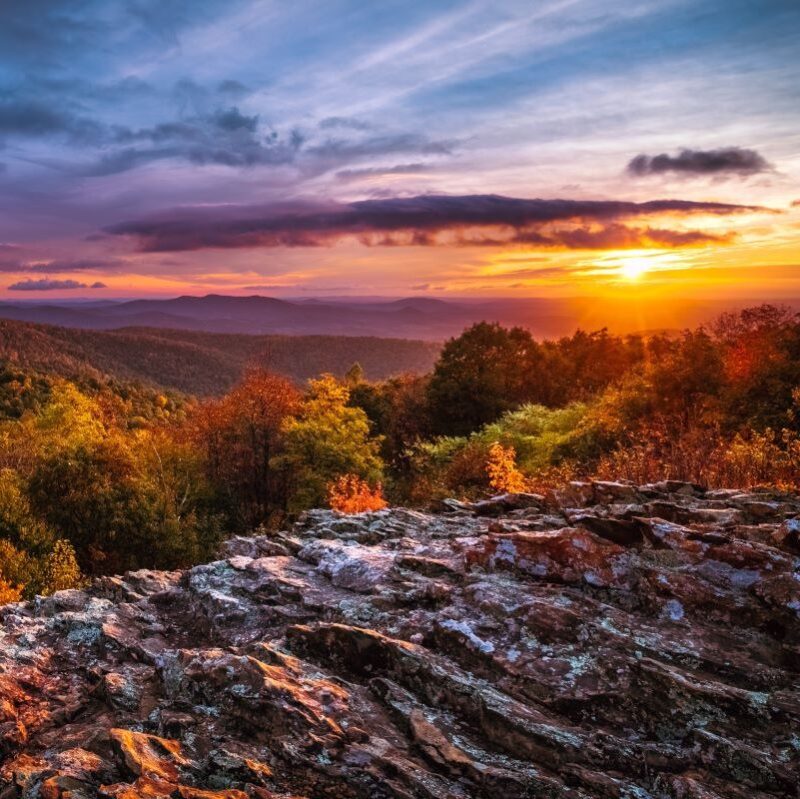
Shenandoah National Park, which extends along the Blue Ridge Mountains in Virginia, includes more than 200,000 acres of protected lands. Whether you’re driving along the park’s Skyline Drive or hiking its network of trails, which includes a section of the long-distance Appalachian Trail, you’ll see cascading waterfalls, scenic vistas, and wooded hollows — not to mention songbirds, deer, and black bears.
Videos by TravelAwaits
It isn’t as if Shenandoah National Park is a secret, however. The park, located just 75 miles outside Washington, D.C., drew 1.6 million visitors last year.
The good news is that there’s no reason to let the park’s popularity and crowds keep you from visiting. In fact, the National Park Service recently released its “Top 10 Tips for Visiting Shenandoah in the Summer” to help you plan a fantastic trip this summer.
“So what’s the best way to have fun in Shenandoah National Park? Plan ahead!” according to the park rangers who wrote the tips. “Unmet expectations can be a major cause of frustration, so know what you’re getting into before you come to Shenandoah.”
With that in mind, here are park rangers’ tips to make sure the memories you have of Shenandoah are good ones.
1. It’s All About Timing
Shenandoah is a popular national park. As you would expect, weekends — Fridays through Sundays — are typically busier than weekdays during the summer. Rangers recommend arriving at the park as early as possible on a weekday. That way, you’ll be able to avoid long lines at entrance stations and find parking spaces at trailheads, they explain.
2. Buy A Park Pass Early
Everyone is required to pay an entrance fee to access Shenandoah National Park — whether they drive in on Skyline Drive or hike in on a trail. Due to the potential for long lines at entrance stations during the summer, rangers strongly encourage visitors to purchase their entrance pass in advance and online.
There are other pass options as well. For instance, you can purchase an annual America the Beautiful Pass (good for entry to any national park site that charges a fee), a Senior Pass (for visitors 62 and older), or the Shenandoah National Park Annual Pass (good for one year from the time of purchase). You can learn more about the various passes and how to purchase them here.
3. Make Reservations
Rangers explain that since Shenandoah is so popular, you’ll need to reserve campsites and lodging ahead of time. If those accommodations are already full, you’ll need to find commercial cabins, campgrounds, hotels, or motels outside the park.
You can learn more about lodging, campgrounds, and backcountry camping at Shenandoah here.
4. Be Prepared
If you want to camp in the backcountry, you’ll need to be prepared, rangers explain. The park does not have designated backcountry campsites, so camping is dispersed. Rangers advise studying detailed trail maps ahead of time and making sure that you know backcountry regulations. You can find those regulations here.
Pro-Tip: A free backcountry camping permit is required to camp in Shenandoah’s backcountry. You can fill the permits out at self-registration kiosks at the four entrance stations on Skyline Drive as well as Old Rag and Whiteoak Canyon trailheads, but you can avoid crowds by filling them out online and in advance. You can do that here.
5. Mind Your Pets
Shenandoah National Park is one of the few national parks that allow pets on trails — but not on all trails. Where they are allowed, dogs must be kept on a leash no longer than 6-feet long at all times. Also, be sure to clean up after your pets and carry out the trash.
You can find more information about where pets are — and aren’t — allowed here.
6. Stay On The Trail
In addition to numerous small cascades along mountain streams, every district in Shenandoah has large waterfalls.
“Enjoy waterfalls from the viewpoints provided or from a safe distance,” rangers recommend. “Many injuries in the park are caused by people climbing waterfalls. Wet rocks are slippery!”
You can learn more about hiking to waterfalls at Shenandoah here.
Pro-Tip: All of the park’s waterfalls are accessible from a parking place along Skyline Drive. However, keep in mind that you’ll need to hike downhill to the waterfalls — and then back uphill to parking lots.
7. Talk To Rangers
Park rangers are stationed at both visitor centers. Feel free to stop and ask them questions, and even pick up a trail map.
The Dickey Ridge Visitor Center is located near Front Royal, Virginia, in the northern part of the park, while the Byrd Visitor Center is located across from Big Meadows in the center of the park. You can find more information about both centers, including their amenities, here.
8. Take The Path Less-Traveled
Rangers know everyone wants to hike popular trails such as Old Rag and Dark Hollow Falls, but it’s also possible to hike trails and see summits and waterfalls away from the crowd.
“While many of the more-popular trails can get crowded during the summer and fall seasons, there are plenty of miles of lesser-known areas to stretch out on if seclusion is more your thing,” rangers explain. “Not only can it be more enjoyable for you, it can also help us to minimize our impacts on well-traversed natural areas.”
You can learn more about the scenic but lesser-known, trails here.
9. Take It Slow
There are good reasons for the speed limit along Skyline Drive to be 35 miles per hour in most places. First of all, the scenic drive winds a great deal — and has tight curves in some places. Secondly, that speed will allow drivers to brake safely if wildlife such as deer, bears, squirrels, bobcats, or turkeys suddenly step into the road. Finally, Skyline Drive doesn’t have a shoulder, so drivers may need to brake suddenly if they come upon bicyclists or hikers.
“Give yourself plenty of time to get where you want to go!” rangers recommend.
10. Download What You Need to Know
Rangers recommend downloading the NPS App to help plan your trip because it lets you explore more than 400 national park sites using interactive maps and self-guided tours. It also includes information about accessibility, amenities such as food and restrooms, news, and alerts.
Pro-Tip: Be sure to download content in advance for offline use because cellular service will not be available in some remote areas of Shenandoah.
Finally, if you’re planning a trip, be sure to check out all of our Shenandoah National Park and hiking coverage. And don’t forget to read our Washington and Virginia coverage as well.
